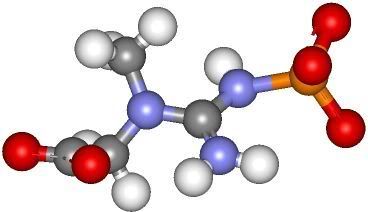High intensity exercise of short duration (ie.100m dash, 25m or heavy ass squats) requires an immediate energy supply. This comes almost soley on banked stores of intramuscular, high-energy phosphates, phosphagens, adenosine triphosphate (ATP) and phosphocreatine (PCr). Each kilogram of skeletal muscle (the kind of muscle you use when you workout) contains 3 to 8 mmol/l (millimoles/litre) of ATP and 4–5 times more PCr. For a 70kg person, with a muscle mass of 30kg, this represents between 570 to 690 mmol/l of high-energy phosphates. Assuming that 20kg of muscle becomes active during “big-muscle” exercise, sufficient stored phosphagen energy can supply energy for 5-8 seconds of sprint running for 5–8 seconds, or up to 15 seconds of heavy, maximal effort weight lifting.
All sports use the high-energy phosphates, but many depend almost entirely on this means of energy transfer. For example, success in football and the gym requires brief but maximal efforts during the performance. Sustaining exercise beyond a brief period and recovering from all-out effort requires an additional energy source to replenish ATP. If this does not occur, the “fuel” supply diminishes and high-intensity movement comes to a screeching halt. The carbohydrates, fat, and protein found within the cellular fluids and tissue depots remain ready to continually recharge the available pool of high-energy phosphates to sustain muscular activity. However, there are other methods of help maintaining this energy currency. This is where creatine comes into play.
When creatine is consumed it passes through the digestive tract intact and eventually gets shuttled into skeletal muscle. About 40% exists as free creatine; the remainder combines with a phosphate molecule to form PCr.
PCr also shuttles intramuscular high-energy phosphate between the mitochondria and muscle filament cross-bridge sites that initiate muscle action. Maintaining a high ratio of ATP:ADP (adenosine diphosphate) ratio is important for maximum effort activities lasting up to 3-15 seconds. This exercise duration places high demands on ATP re-synthesis that exceed the energy transfer from intracellular macronutrient breakdown.
Generally speaking, creatine has the potential to accomplish the following:
- Accelerate ATP turnover to maintain power output during short-term muscular effort
- Delay PCr depletion
- Diminish dependence on anaerobic glycolysis and decrease resulting lactate formation
- Facilitate muscle relaxation and recovery from repeated bouts of intense, brief effort via faster ATP and PCr resynthesis; rapid recovery allows continued higher level power output
Molecular Structure of PCr
Molecular Structure of ATP
Kurt Kuhn - http://www.fusionbodybuilding.com/

